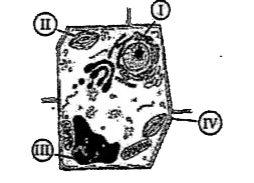Growth of Cell plate in plant cells is
Centrifugal
Centripetal
Random
Partially centripetal
The correct Answer is:A
To answer the question about the growth of the cell plate in plant cells, we will follow these steps:
1. Understanding Cell Plate Formation:
- In plant cells, during the process of cytokinesis (the final stage of cell division), a structure known as the cell plate forms. This is crucial for the separation of the two daughter cells.
Hint: Remember that the cell plate is specific to plant cells and is different from the cleavage furrow seen in animal cells.
2. Origin of the Cell Plate:
- The cell plate originates from the phragmoplast, which is a structure that helps in the formation of the new cell wall between the dividing cells.
Hint: The phragmoplast is essential for the cell plate's development; think of it as the scaffolding for the new wall.
3. Direction of Growth:
- The cell plate grows from the center of the cell towards the lateral walls. This means it expands outward, away from the center.
Hint: Visualize the cell plate as a pizza being cut from the center outwards, which helps in understanding its growth direction.
4. Centrifugal vs. Centripetal Growth:
- The growth of the cell plate is described as centrifugal because it moves outward from the center. In contrast, centripetal growth would mean moving inward towards the center.
Hint: Remember that "centrifugal" refers to moving away from the center, while "centripetal" refers to moving towards the center.
5. Evaluating the Options:
- Given the options provided:
- Centrifugal (correct)
- Centripetal (incorrect)
- Random (incorrect)
- Partially centripetal (incorrect)
- The only correct answer is the first option, which is centrifugal.
Hint: When evaluating options, always refer back to the definitions and characteristics of the processes involved.
Final Answer:
The growth of the cell plate in plant cells is centrifugal.
- In plant cells, during the process of cytokinesis (the final stage of cell division), a structure known as the cell plate forms. This is crucial for the separation of the two daughter cells.
- The cell plate originates from the phragmoplast, which is a structure that helps in the formation of the new cell wall between the dividing cells.
- The cell plate grows from the center of the cell towards the lateral walls. This means it expands outward, away from the center.
- The growth of the cell plate is described as centrifugal because it moves outward from the center. In contrast, centripetal growth would mean moving inward towards the center.
- Given the options provided:
- Centrifugal (correct)
- Centripetal (incorrect)
- Random (incorrect)
- Partially centripetal (incorrect)
- The only correct answer is the first option, which is centrifugal.
The growth of the cell plate in plant cells is centrifugal.
Similar Questions
Knowledge Check
Cell wall of plant cell is
Asemi-permeableBselectively permeableCfully permeableDimpermeable.A cell at telophase stage is observed by a student in a plant brought from the field. He tells his teacher that this cell is not like other cells at telophase stage. There is no formation of cell plate and thus the cell is containing more number of chromosomes as compared to other dividing cells. This would result in
ApolyploidyBsomaclonal variationCpolytenyDaneuploidyA cell at telophase stage is observed by a student in a plant brought from the field. He tells his teacher that this cell is not like other cells at telophase stage. There is no formation of cell plate and thus the cell is containing more number of chromosomes as compared to other dividing cells. This would result in
AAneuploidyBPolyploidyCSomaclonal variationDPolyteny
The given diagram depicts cell plate method of cytokinesis in plant cells. Identify A,B and C

View SolutionA cell at telophase stage is observed by a student in a plant brought from the field. He tells his teacher that this cell is not like other cells at telophase stage. There is no formation of cell plate and thus the cell is containing more number of chromosomes as compared to other dividing cells. This would result in
View SolutionA cell al telphases stage is observed by a student in a plant brought from the filed. He tells his teacher that this cell is not like other cells at telophases stage. There is no foramation of cell plate an thus cell is containing more number of chormosomes as compared to other dividing cells. This would result in
View SolutionA cell at telophase stage is observed by a student in a plant brought from the field. He tells his teacher that this cell is not like other cells at telophase stage. There is no formation of cell plate and thus the cell is containing more number of chromosomes as compared to other dividing cells. This would result in
View SolutionThe layer of the cell wall that develops from the cell plate during cell division is
View Solution

